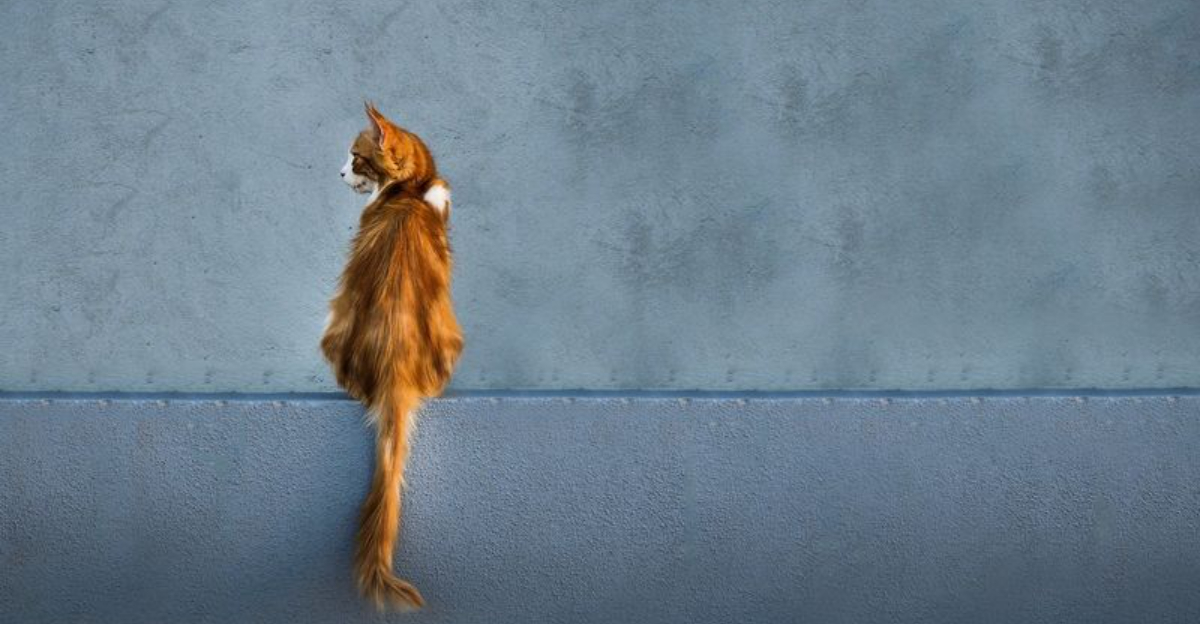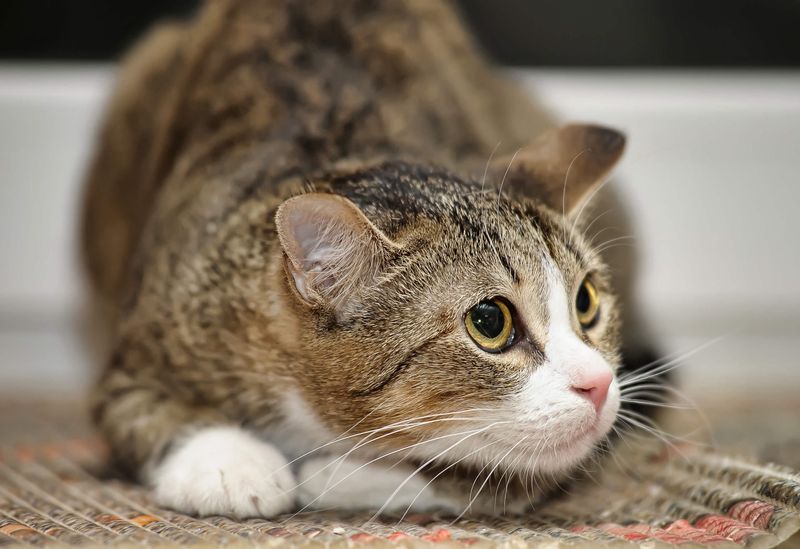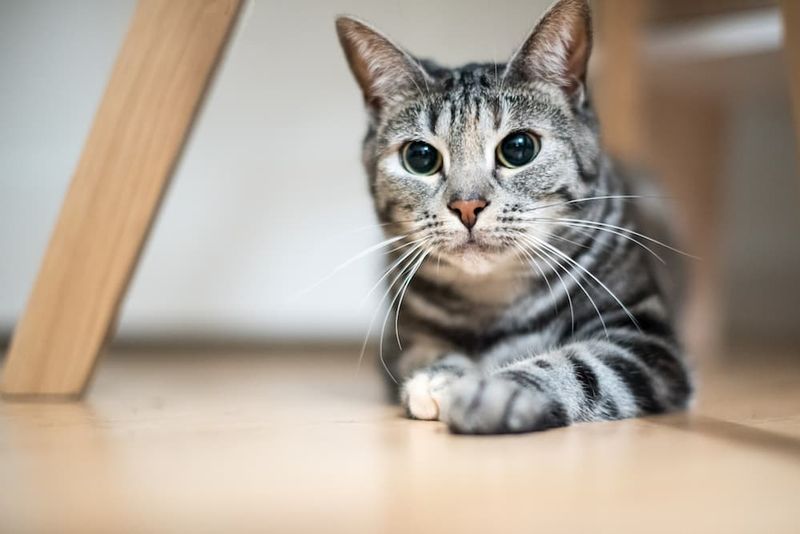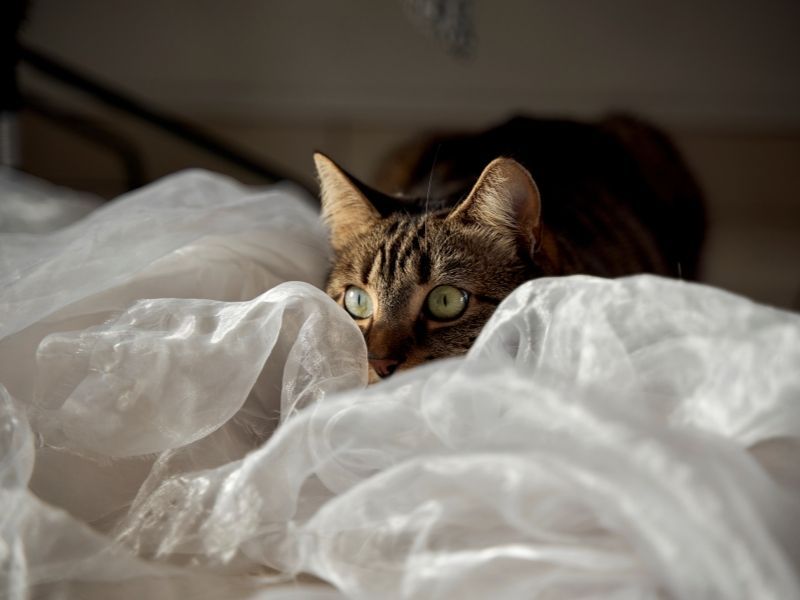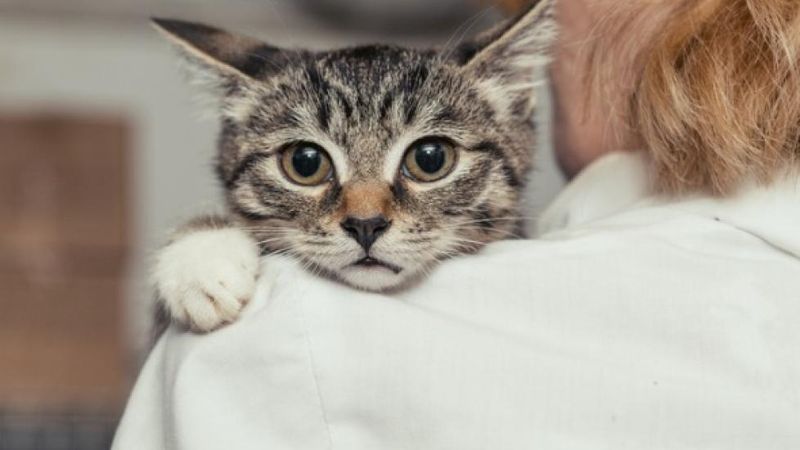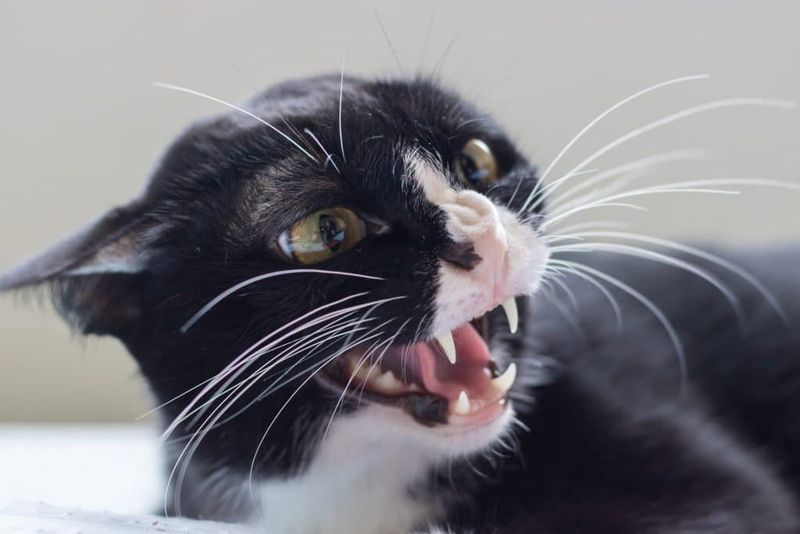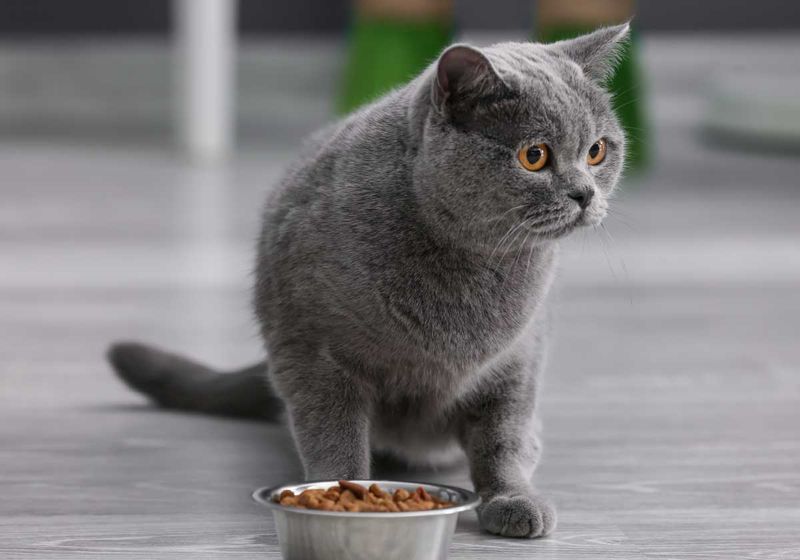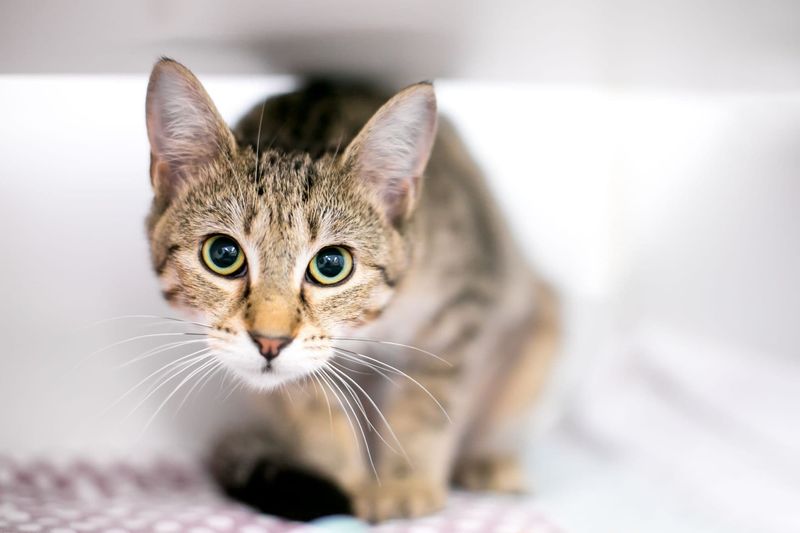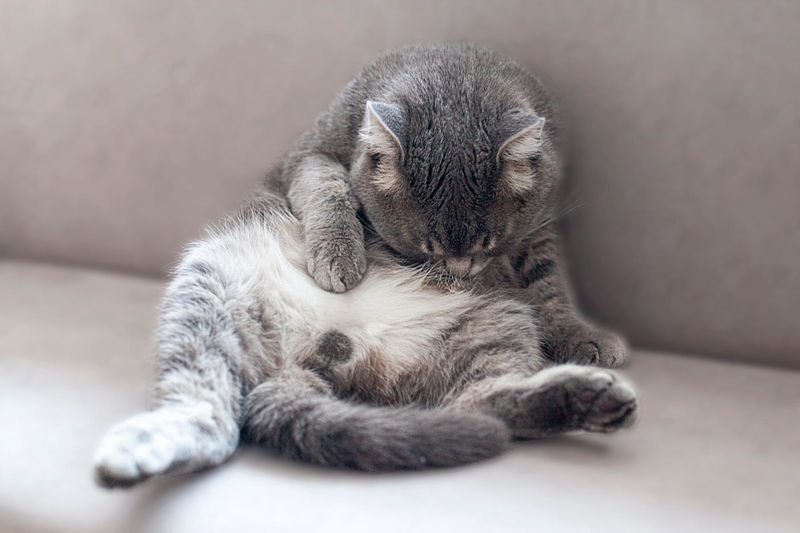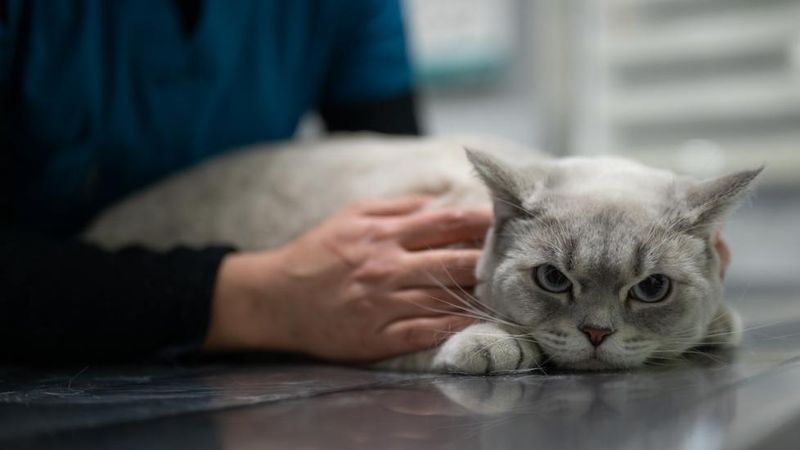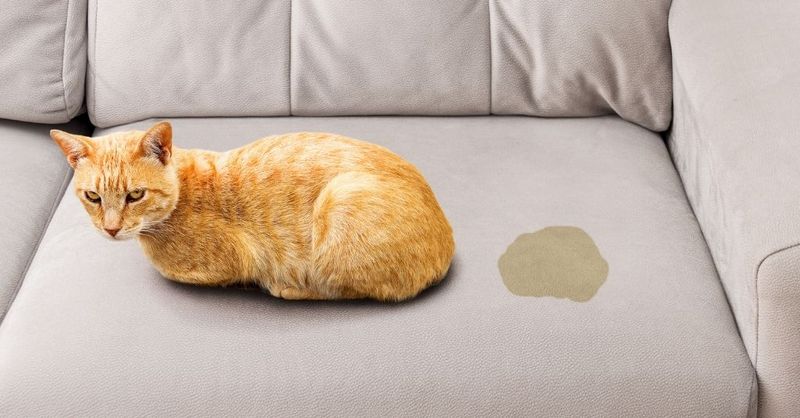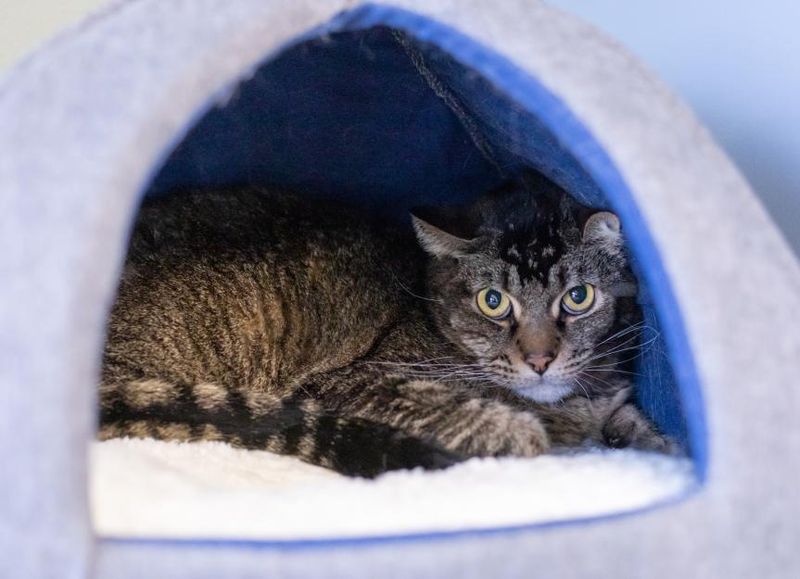📖 Table of Content:
- 1. Flattened Ears
- 2. Dilated Pupils
- 3. Hiding or Avoiding
- 4. Tense Body Posture
- 5. Tail Tucked or Flicking
- 6. Sudden Freezing
- 7. Low Growling or Hissing
- 8. Refusing Food or Treats
- 9. Hypervigilance
- 10. Over-Grooming or No Grooming
- 11. Trembling or Shaking
- 12. Inappropriate Elimination
- 13. Clinginess or Avoidance
Cats are often seen as mysterious, independent creatures, but beneath their quiet demeanor lies a complex emotional world. While they may not cry out or cling like dogs when something feels off, cats have their own subtle—and sometimes surprising—ways of expressing fear and anxiety. As a cat parent, learning to read these cues can make all the difference in helping your feline friend feel secure and supported.
Fear in cats isn’t always loud or dramatic. In fact, it’s usually the opposite. From a slight shift in posture to a flick of the tail or change in grooming habits, cats communicate their discomfort in ways that can easily be missed if you’re not paying close attention. These behaviors aren’t just quirks—they’re messages. And tuning into them can strengthen your bond and prevent stress-related issues before they escalate.
Whether your cat is reacting to a loud noise, a new environment, or even subtle changes in their routine, knowing the signs of fear is the first step toward easing their stress. In this article, we’ll explore 13 gentle yet telling ways cats try to let us know they’re feeling nervous. The more you understand their silent language, the better you can respond with the care and comfort they need.
1. Flattened Ears
During stressful moments, a cat’s ears can transform into an unmistakable sign of distress. To the untrained eye, this might appear as a fleeting gesture—but it’s packed with meaning. When a cat flattens its ears sideways or back, they’re preparing for potential danger. Interestingly, this behavior is instinctual, a way to protect their ears from harm in a fight or flight scenario. At times, it can accompany growling or hissing as a more direct plea for space. Keep in mind that ears flicking back and forth rapidly may also indicate indecision or internal conflict. Without warning, a relaxed cat can go from curious to alarmed just by hearing a sudden noise or encountering a new person. Flattened ears are like tiny red flags—easy to miss, but important to catch.
2. Dilated Pupils
To the untrained eye, dilated pupils in cats might seem adorable—but they often reflect emotional tension. During stressful situations, even bright lighting may not prevent a cat’s pupils from expanding. Interestingly, wide pupils allow more light in for quick reactions—a classic fight-or-flight response. When you observe this in a well-lit room, it’s a strong clue your cat is scared. At times, dilated eyes can be accompanied by crouching or twitching tails. Keep in mind that excitement and fear both cause pupil dilation, so context matters. Though often subtle, this eye change can happen in an instant when a trigger appears. Another behavior to note is how long the dilation lasts—prolonged widening usually means your cat isn’t feeling safe.
3. Hiding or Avoiding
It’s worth noting that hiding is one of the most instinctual fear responses in cats. During stressful moments, your cat may vanish under the couch or into a closet without warning. Without much fanfare, this behavior is often the safest and most calming option for them. Though often subtle, even avoiding eye contact or staying in another room can count as a hiding behavior. Another behavior to note is when your cat retreats after a specific event—like a vacuum turning on or a guest arriving. Interestingly, cats sometimes have “preferred” hiding spots that they only use during anxiety. To the untrained eye, this might look like laziness, but it’s actually a form of self-protection. Keep in mind that forcing a scared cat out of hiding can backfire—patience and gentle reassurance work better.
4. Tense Body Posture
Interestingly, a cat’s body language is one of the quickest ways to sense fear. Without warning, a relaxed feline can become a tight, low-slung figure with muscles ready to spring. During stressful moments, you may notice their body stiffen and their back arch slightly—without the playful bounce. To the untrained eye, this posture may look like they’re preparing to pounce, but it’s often a defensive position. Keep in mind that even their paws may be curled inward, showing they’re not ready to interact. Though often subtle, the difference between a tense and calm stance is something owners can learn to spot. Many cat owners may not realize that a rigid tail, stiff back, and flattened posture all point to unease. When you observe this, avoid sudden movements or loud noises—your cat needs calm reassurance.
5. Tail Tucked or Flicking
Another behavior to note is a cat’s tail language, which can reveal volumes about their emotional state. During stressful moments, a cat might tuck their tail tightly under their body as a clear sign of fear. Without warning, that same tail might flick rapidly from side to side, indicating agitation or anxiety. Interestingly, this behavior often accompanies other cues like dilated pupils or pinned-back ears. When you observe this, it’s best to give your cat space and let them settle on their own terms. Though often subtle, a tail that lashes repeatedly may be signaling overstimulation. Many cat owners may not realize that what looks like random tail movement is actually their cat expressing discomfort. Keep in mind that a relaxed tail is loose and slow-moving—anything tighter or quicker could mean your cat is nervous.
6. Sudden Freezing
At times, a scared cat will suddenly stop all movement and freeze in place. Without making a sound, they may crouch low with wide, unblinking eyes, fully focused on whatever has alarmed them. During stressful moments, this freeze response is a survival instinct—remaining still to avoid drawing attention. Interestingly, it may look like your cat is simply “staring off,” but it often signals internal panic. Keep in mind that freezing may be followed by a quick bolt to a safe space. Another behavior to note is the lack of blinking, which can indicate extreme alertness or fear. Many cat owners may not realize that their cat is overwhelmed during these still episodes. To the untrained eye, it seems like a pause—but it’s a quiet cry for security.
7. Low Growling or Hissing
Another behavior to watch for is low growling or hissing—vocalizations that may sound aggressive but are usually rooted in fear. Without warning, a frightened cat may growl in response to an unfamiliar noise, person, or situation. During stressful moments, hissing acts as a defensive alarm, a warning to “stay away.” Interestingly, these sounds are more about self-protection than confrontation. To the untrained ear, it may seem like your cat is being “mean,” but they’re really just scared. Keep in mind that hissing is often paired with flattened ears and a tucked tail. At times, even a friendly pet or approach can trigger this reaction if your cat feels cornered. Many cat owners may not realize that giving them space in that moment is the kindest thing you can do.
8. Refusing Food or Treats
To the untrained eye, skipping a meal may seem harmless—but in cats, it can signal deeper emotional discomfort. During stressful moments, even their favorite treat might go untouched. Interestingly, this is a survival mechanism; in the wild, eating while anxious could make them vulnerable. Another behavior to note is avoiding the food bowl entirely, as if the environment feels unsafe. Keep in mind that cats are creatures of habit, and a change in eating patterns often means something is wrong. Without warning, a minor household change—a new pet, loud noises, or even different furniture—can disrupt their appetite. Many cat owners may not realize that emotional stress often manifests through food refusal. At times, coaxing with quiet and gentle encouragement can help, but patience is key.
9. Hypervigilance
Many cat owners may not realize that constant scanning of the environment is a sign their cat feels on edge. Without warning, your cat might flinch at soft noises or seem glued to every shadow in the room. During stressful moments, this hyperawareness is their way of staying “one step ahead” of perceived threats. Interestingly, some cats may even refuse to relax or sit down when they feel unsafe. Keep in mind that this level of alertness is exhausting for them, even if they don’t show it. At times, you may see their ears swiveling rapidly as they track every sound. To the untrained eye, it could look like playfulness—but it’s actually a state of high alert. Another behavior to note is repeated pacing or hesitation when moving through rooms.
10. Over-Grooming or No Grooming
Interestingly, grooming is one of the ways cats cope with emotional stress—but it can easily go too far. Without warning, a cat may begin licking the same area repeatedly, sometimes causing bald patches. During stressful moments, this ritual becomes compulsive—a calming activity to help them self-soothe. At times, though, the opposite occurs: grooming stops altogether as anxiety overwhelms their usual routines. Keep in mind that both behaviors—excess or absence—signal emotional distress. To the untrained eye, the over-grooming may be mistaken for cleanliness or the neglect as laziness. Many cat owners may not realize that changes in grooming are a key early warning sign of fear. Another behavior to note is if the grooming seems frantic, especially after a perceived threat has passed.
11. Trembling or Shaking
Keep in mind that physical trembling in cats is not always cold-related—it can be a visible sign of fear. Without warning, your cat may begin to shiver after a loud noise, unfamiliar visitor, or sudden movement. Interestingly, trembling is often one of the clearest physical signs of emotional overwhelm. During stressful moments, their body may react before their behavior does. To the untrained eye, it might look like your cat is simply stretching or adjusting posture, but subtle shakes shouldn’t be ignored. At times, this trembling is isolated to their legs or tail and may stop when they’re comforted. Many cat owners may not realize that this shaking can linger well after the stressful event ends. Another behavior to note is trembling that appears during vet visits, thunderstorms, or car rides—common triggers for feline anxiety.
12. Inappropriate Elimination
During stressful moments, cats may urinate or defecate outside their litter box—not out of spite, but because of emotional overload. Interestingly, this behavior often signals that something in their environment feels unsafe or unpredictable. Without warning, even a fully litter-trained cat may have an accident if they’re frightened. To the untrained eye, it might seem like a behavioral issue, but it’s more often an emotional response. Another behavior to note is if your cat starts eliminating near doors, windows, or specific rooms—potential signs of stress-related marking. Keep in mind that medical causes should always be ruled out first, but once cleared, anxiety becomes the likely culprit. Many cat owners may not realize that changes in routine, guests, or conflict with another pet can trigger this behavior. At times, reestablishing a calm and predictable environment can resolve the issue completely.
13. Clinginess or Avoidance
Another behavior to note is a sudden change in your cat’s social needs—either wanting constant closeness or total isolation. Interestingly, both responses are valid ways cats try to handle fear. Without warning, your cat may jump into your lap and refuse to leave, or they might disappear into another room for hours. At times, even your most independent feline may become clingy during thunderstorms, loud events, or visits from strangers. Keep in mind that avoidance isn’t rejection—it’s often a way to manage overwhelming feelings. Many cat owners may not realize that these changes are direct responses to emotional stress. During stressful moments, your cat is simply choosing the strategy that feels safest to them. To the untrained eye, it may seem confusing—but both extremes can be cries for comfort.
